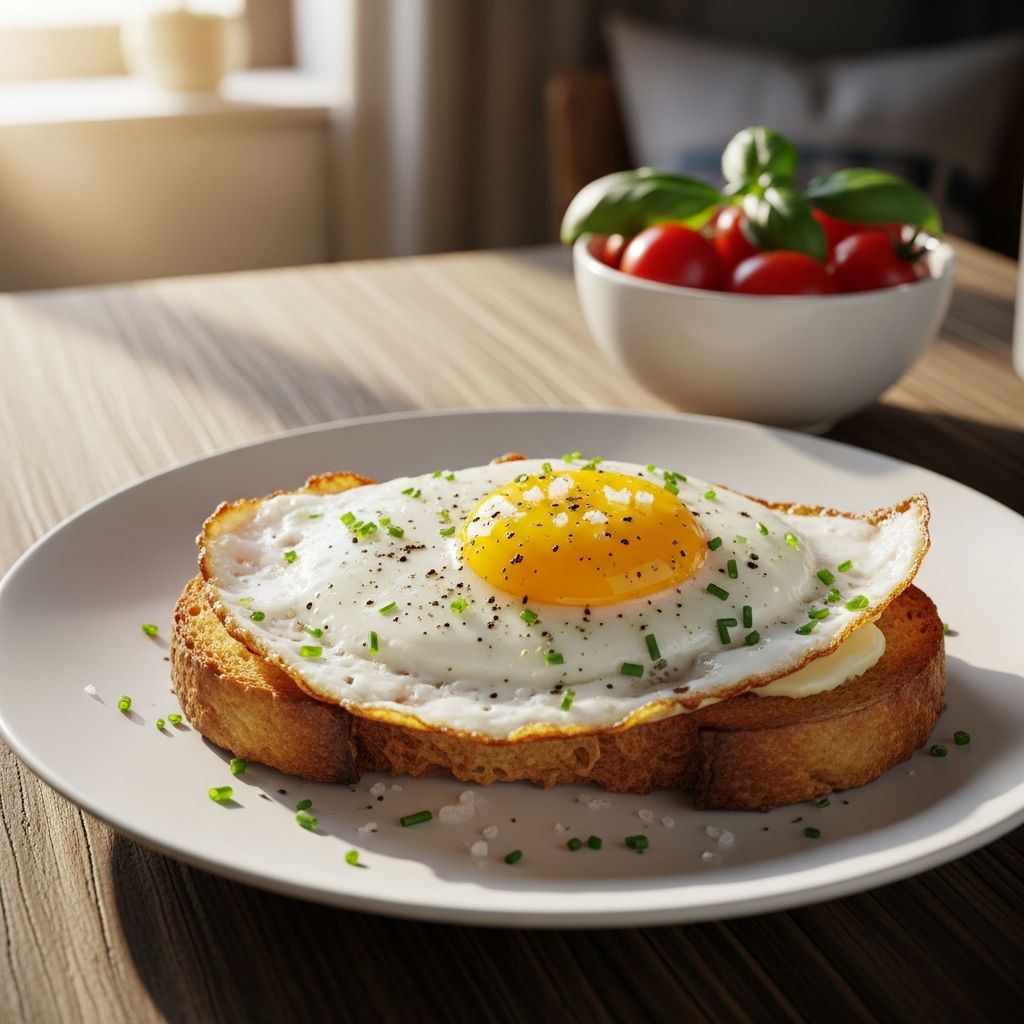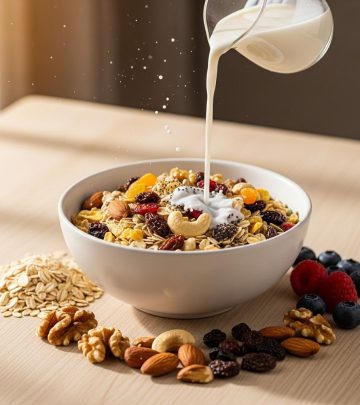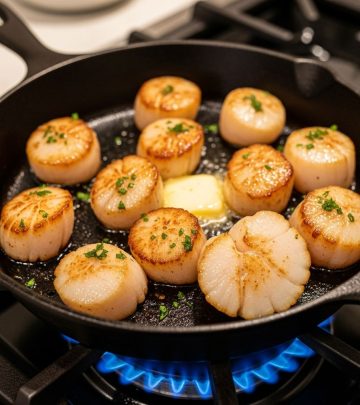My Favorite Fried Egg on Toast: A Perfect Breakfast Classic
Discover the simple yet sublime art of making the perfect fried egg on toast, with tips, variations, and the magic that turns breakfast into a daily delight.

My Favorite Fried Egg on Toast
Few breakfast dishes manage to capture comfort, simplicity, and satisfaction the way fried egg on toast does. This classic isn’t just a staple; it’s a canvas for morning creativity and the ultimate answer to hurried weekdays or leisurely weekend brunches. Discover what makes the perfect fried egg on toast and how thoughtful detail transforms an everyday meal into a moment to savor.
Why Fried Egg on Toast is a Classic
There’s a beautiful simplicity in good bread, a perfectly cooked egg, and the right accents. For breakfast-lovers and skeptics alike, fried egg on toast bridges the gap—it’s speedy enough for busy mornings and adaptable for gourmet weekends. The basic recipe is deceptively simple, yet mastering it relies on attention to texture, balance, and each flavorful layer.
Ingredients
- 1 thick slice rustic country-style bread: Sturdy and crusty bread holds up best to the soft egg and toppings.
- 1 tablespoon good-quality mayonnaise: Adjust to taste for a creamy, tangy base.
- 2 pinches smoked paprika: Adds subtle spice and a whisper of smokiness.
- 1 generous pat of butter: For frying, adding richness and nutty flavor.
- 1 large egg (or 2 for a heartier meal): The star of the dish, cooked just right.
- Salt and freshly ground black pepper: To finish, enhancing every flavor.
Step-by-Step Directions
This section guides you through each stage with precision and attention to the little details that elevate the finished toast.
Step 1: Toast the Bread
- Begin with your favorite rustic or country-style bread.
- Toast until golden brown and edges are crisp—this ensures strength and crunch against the egg’s richness.
- While warm, spread a thin, even layer of mayonnaise. A slight tang and creaminess play beautifully with the egg’s flavors.
- Top the mayo with a couple of pinches of smoked paprika, distributing it for subtle warmth and color.
Step 2: Fry the Egg
- Use a small pan, preferably not non-stick (cast iron works especially well), and set it over medium-high heat.
- Add a generous pat of butter; wait as it melts, foams, settles, and begins to brown lightly—this brings a nutty, browned butter note.
- When the pan is hot and the butter just begins to brown, crack in the egg. The egg should sizzle on contact.
- Sprinkle the egg liberally with salt (and pepper if desired).
- Turn the heat down to medium-low. Covering the pan at this stage helps the egg white cook gently and evenly, while preserving a runny, glossy yolk.
- Fry until the white is just set but yolk remains soft—timing is key, so watch closely.
Step 3: Assemble and Serve
- Transfer the cooked egg onto your prepared toast.
- If there’s leftover browned butter in the pan, scrape it over the top for extra flavor.
- Finish with a sprinkle of freshly ground black pepper.
- Enjoy immediately, so the egg is hot, the yolk is runny, and the toast stays crisp.
The Art and Science of a Perfect Fried Egg
The detail that makes this toast extraordinary comes down to timing, temperature, and ingredients:
- Butter Browning: Waiting for the butter to foam and start browning ensures maximum flavor and prevents sticking.
- Pan Temperature: A hot pan crisps edges, while lowering the heat protects the yolk and ensures tenderness.
- Covering the Pan: Speeds up the set of the whites and shields the yolk, preventing rubbery edges.
- Mayonnaise and Smoked Paprika: Uncommon on toast, they enrich, add tang, and complement the egg’s delicateness.
How to Choose and Prepare Ingredients
Bread
- Opt for a hearty, thick slice – rustic sourdough, boule, or country white are ideal.
- If using store-bought sandwich bread, double up slices or toast extra thoroughly for structure.
Eggs
- Fresh, large eggs yield the best results, with firmer whites and vivid yolks.
- Room-temperature eggs are less likely to splatter and cook more evenly.
Butter
- Quality counts: use European-style or cultured butter for the richest flavor.
- For dietary flexibility, coconut or olive oil can stand in, but butter’s browning is unique.
Tips, Tricks, and Variations
- For Crispier Edges: Increase pan heat at first, then reduce. A cast iron pan accentuates crispy contrast.
- Less Mess: Crack eggs into a bowl first (especially useful for multiple servings or avoiding shell fragments).
- Texture Tweaks: Leave yolk runny, medium, or fully cooked to your liking. A covered pan shortens cooking time but changes the yolk’s set.
- Flavor Variations:
- Add sliced avocado for creaminess and nutrition boost.
- Top with chopped chives or parsley for herbal freshness.
- Swap the smoked paprika for za’atar, chili flakes, or curry powder for international twists.
- Include a slice of cheese between toast and egg for richer flavor.
Nutrition and Benefits
| Ingredient | Key Nutrients | Benefits |
|---|---|---|
| Bread | Carbohydrates, Fiber, B Vitamins | Energy, digestive health |
| Egg | Protein, Choline, Vitamin D, B12 | Muscle repair, cognition, metabolism |
| Butter | Fats, Vitamin A | Energy, fat-soluble vitamins |
| Mayonnaise | Healthy fats (if olive/canola-based) | Flavor, satiety |
| Smoked Paprika | Antioxidants, Vitamin A | Color, subtle heat |
Serving Suggestions and Pairings
- For a simple breakfast: Serve with black coffee, orange juice, or a light fruit salad.
- Level it up: Accompany with smoked salmon, wilted greens, or roasted tomatoes for a weekend brunch feast.
- Double up the eggs and pair with a crisp salad for a hearty meal at any time.
- Make into an open-faced sandwich by adding thin slices of ham or turkey beneath the egg.
Frequently Asked Questions
Q: Can I make this recipe vegan?
A: For a vegan take, use a hearty seeded bread, vegan mayo, plant-based butter, and a tofu “egg” or seasoned chickpea pancake in place of the fried egg. Smoked paprika and pepper remain great finishing touches.
Q: What type of pan works best for frying eggs?
A: A small cast iron or stainless steel skillet gives the best results for crisp edges and browning. If you use nonstick, you’ll get gentler color and less crisping, but less risk of sticking.
Q: How do I prevent the egg from sticking?
A: Ensure your pan is well-heated before adding butter, and wait for the milk solids in the butter to brown slightly before cracking in the egg. Use a thin spatula to gently loosen and lift the egg when transferring.
Q: Can I make this ahead of time?
A: This recipe is best enjoyed immediately. You can prep the toast and toppings in advance, but the egg should be cooked just before serving for optimal texture.
Q: Which toppings work well for extra flavor?
A: Try hot sauce, salsa verde, shredded cheese, thin-sliced cucumber, or pickled onions. Fresh herbs or microgreens add freshness and color.
Beyond Toast: Creative Variations
Take inspiration from global versions or put your own spin on the classic:
- Spanish-Style: Fry the egg in olive oil and garnish with jamón and roasted peppers.
- Korean-Inspired: Top with gochujang, scallions, and sesame seeds, and serve on milk toast.
- California Fresh: Add sliced avocado, heirloom tomato, and microgreens for a West Coast vibe.
- Mediterranean: Swap mayo for a garlicky labneh and sprinkle with za’atar.
Tips for Scaling Up
- Want to serve a brunch crowd? Toast bread in the oven on a baking sheet and fry eggs in batches, keeping them warm on a tray. Let guests customize with toppings buffet-style.
- Use larger pans or multiple skillets if making for several people.
Conclusion
Embracing the ritual of making fried egg on toast—however simple—offers a nourishing and satisfying foundation for any day. Whether you stick to the core recipe or branch out into inventive territory, this dish is proof that the greatest pleasures often lie in everyday classics, done just right.












